The Arctic Circle is the farthest northern of the five major circles of latitude on the planet. It marks the northernmost point at which the center of the noon sun is just visible on the winter solstice . During the summer solstice , the heart of the midnight sun is just visible at the southernmost point.
Advances in technology are enabling scientists and researchers to discover new insights in this frozen, mysterious wilderness. Geneticists are using genomic studies to unlock DNA puzzles, paleontologists are unearthing once inaccessible dinosaur bones, and even common folk around the globe are using satellite imagery to transform our understanding of the origins of life within the Arctic Circle.
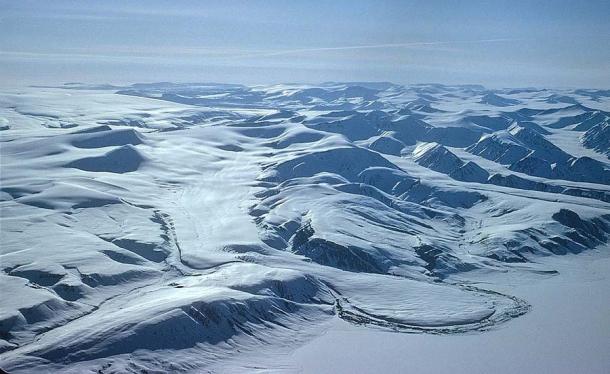
Desolate landscape of Axel Heiberg Island within the Arctic Circle. (Matti&Keti / CC BY-SA 4.0 )
Dinosaur Discoveries and Debates from the Arctic Circle
In 2014, it was reported by CBC Science that a dinosaur fossil from Canadian High Arctic, the most northerly dinosaur fossil ever discovered. The fossil is a vertebra from the spinal cord of a duck-billed species known as a hadrosaur. It was discovered on Axel Heiberg Island in Nunavut, about 500 kilometers (310 miles) north of the closest human habitation.
Hadrosaurs were herbivores who sported stylish duckbills and sometimes crests atop their heads, and this particular hadrosaur was about 8 meters (26 ft) long. Vavrek, curator and head paleontologist at the Philip J. Currie Dinosaur Museum in Grand Prairie, Alta., explained that the discovery helps to reveal the true range of where dinosaurs once roamed.
Vavrek also said that paleontologists have barely looked for dinosaur fossils in the Canadian High Arctic because of its exorbitant cost and brutal logistics to get there. They also have to contend with the reality that permafrost tends to break up fossil skeletons as it grinds through its freeze-thaw cycles. But he is confident that there are still many fossils left to be discovered there.
Alaska Dinosaur Discoveries and Dino Debates
Across the continent on the Alaskan side, more recent reports of dinosaur fossil excavations emerging within the Arctic Circle are stirring up some debate in the paleontology community. Dr. Pat Druckenmiller, Director of the University of Alaska Museum of the North is the lead author of a study just published in the journal Current Biology . Druckenmiller believes that their fossil findings (70-million-year-old baby dinosaur bones and eggs) upend past assumptions that dinosaurs were cold-blooded reptiles.
“If they reproduced, then they over-wintered there. If they overwintered there, they had to deal with conditions that we don’t usually associate with dinosaurs, like freezing conditions and snow. At least these groups had endothermy,” he stated, referring to the ability of animals to heat their bodies through internal functions.
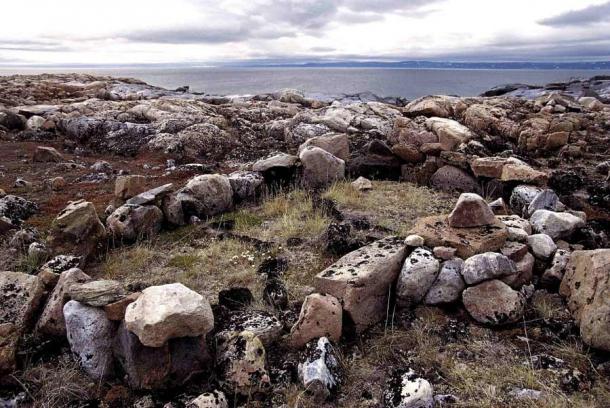
Remnants of an ancient Thule dwelling. (Ansgar Walk / CC BY-SA 2.5 )
The Enigmatic Dorset Culture and the Qajartalik Petroglyphs of the Arctic Circle
Before the ancestors of the modern Inuit People, also known as Thule People, migrated east from Alaska around 1100 AD, the region had been inhabited for thousands of years by the mysterious Dorset Culture . “Ever since the discovery of a Paleo-Eskimo culture in the North American Arctic in 1925, archaeologists have been mystified by their relationship with the Thule culture ancestors of the modern Inuit,” said Dr. William Fitzhugh, from the Arctic Studies Center at the Smithsonian Institute . They were named after Cape Dorset, Nunavut, where Dorset Culture artifacts were first found in 1925.
These Arctic Circle artifacts immediately stood out as distinct and far more ancient that Inuit objects. The Dorset Culture artifacts depicted men and women wearing hoodless parkas with tall collars. It appears that they did not use bow and arrow technology, nor did they use drills. They did not hunt land animals such as polar bears or caribou like the Inuit, instead relying entirely on hunting ocean mammals like sea lions, walruses, and narwhals. It seems that somewhere between 1000 AD (precisely when the Inuit arrived) and 1500 AD, the Dorset Culture mysteriously vanished.
Qajartalik is one of Canada’s proposed UNESCO World Heritage Sites. It is a series of 150 petroglyph faces carved in stone by the Dorset Culture. Some of the faces are human, some are animals, and some are anthropomorphic. All are carved within a large trough shape in the soapstone. There had been some vandalism of the site recently and to prevent this, the Canadian Government is taking measures to protect the site. The petroglyphs at Qajartalik are the northernmost glyphs ever discovered on Earth.
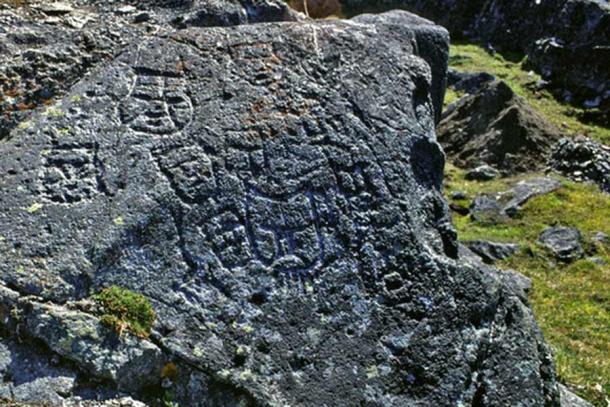
The Qajartalik petroglyph site (JhEv-1) are to be found in the northeast corner of Qikertaaluk Island, on a small peninsula called Qajartalik. ( Avataq Cultural Institute )
Inuit Legends of Encounters with the First Inhabitants: The Lost Race
The Inuit recall legends of their interactions with the Dorset, who they call Tunit, translated as “first inhabitants.” According to the Inuit accounts, the Tunit were powerful, yet timid, giants who lived in stone dwellings. Most of the stories revolve around the Tunit’s spectacular feats of physical strength. For example, it is said by the Inuit that they could lift humongous boulders and carry walruses over their shoulders.
The Tunit people are described as skittish giants by the Inuit, taller and stronger they were said to flee from settlements quickly whenever contact with outsiders occurred. Another name for these original, gigantic inhabitants is the Inupasugjuk .
Inuit elders are reluctant to speak of them and it seems that any encounters with them were rare and occurred in ancient times when the Inuit people first arrived in the Arctic Circle. They recall that the males are extremely rare, and that females were slightly more common. These hairy, reclusive giant females apparently found Homo sapiens amusing, and would occasionally abduct one to keep as a plaything.
According to EurekAlert!, Dr. Eske Willerslev, a professor at the Center for GeoGenetics at the University of Copenhagen coauthored a study in 2014 that, according to Willerslev, confirms the legends to some extent:
“Our genetic studies show that, in reality, the Paleo-Eskimos – representing one single group – were the first people in the Arctic, and they survived without outside contact for over 4,000 years. This new genomic research settles outstanding issues in Arctic archaeology that have been debated for nearly a century, finding that Paleo-Eskimo and Neo-Eskimo people were genetically distinct, with separate origins in Eastern Siberia, and the Paleo-Eskimo remained isolated in the Eastern Arctic for thousands of years with no significant mixing with each other or with American Indians, Norse, or other Europeans.”
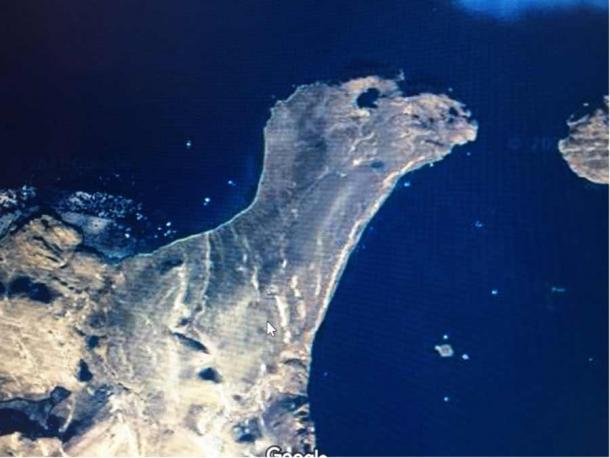
Google Earth image of “sea lion” formation on Island of Kekertaluk. (Google Earth, Author provided)
Strange Satellite Images at Auyuittuq National Park
In the same general area as the Nunavut dinosaur fossils and the Qajartalik petroglyphs (the home of the Dorset Culture), satellite images reveal some strange features within the Auyuittuq National Park. On the western side of the park, where the Davis Strait flows into the many tributaries, an anomaly emerges.
Beneath the brackish waters, there appear to be hundreds, if not thousands, of geometric structures. Right angles, long straight lines, and squares, very reminiscent of ancient city grids, complete with causeways and temples appear to be submerged underwater. It is possible that, given that these are being viewed through the satellite computer programs, that this only an optical illusion. However, of all the tributaries why would only these three produce this digital “noise” effect?
As if these sunken shapes were not strange enough, there are additional anomalies. Even further north, the Island of Kekertaluk, a peninsula extends out from the island into the straight towards Greenland. Oddly enough, this peninsula somehow resembles an enormous head of a sea lion.
Just as with the geometric patterns beneath the tributaries, this may very well be an instance of pareidolia (the human tendency to impose the perception of meaningful images onto a nebulous stimulus). But again, if that were the case, it seems strange that it would not be rampant amongst the countless other geological formations of the area. Furthermore, it is additionally odd that the formation would so clearly represent a sea lion, as they certainly do migrate right past the peninsula and they were the preferred prey of the Dorset Culture.
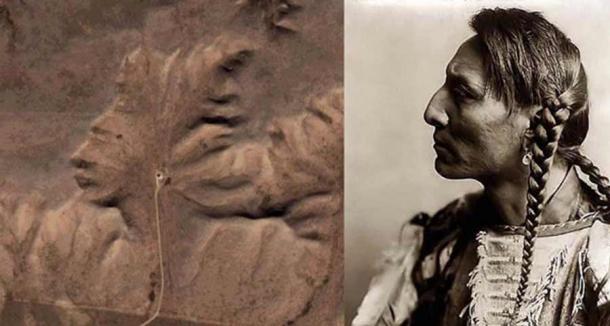
The Badlands Guardian and an indigenous person. It is generally believed that the natural feature’s similarity to an indigenous person with a headdress is an example of pareidolia. ( Thoughts of a Taoist Babe )
Medicine Hat, the Badlands Guardian, and a Peculiar Pattern
The Badland Guardian is the name given to a mountain formation in the town of Medicine Hat, Canada. The town derives its name from a First Nations legend about an ancient and powerful shaman who received a supernatural headdress from a river deity in the area.
There are variations of the story, but the essential elements remain the same: Long ago the shaman encounters a water deity who demands blood sacrifice in exchange for this enchanted headdress. He then loses the headdress and embarks on an epic quest to retrieve it.
In recent years, curious researchers in the comfort of their homes noticed that the mountainous formation in the area of Medicine Hat clearly resembles a Native American man wearing a headdress. Once again, this may be pareidolia, but just as with the arctic anomalies, how could it be that the legend and place name came before the observation of these suggestive features which are only visible from outer space?
This peculiar pattern runs much deeper if one is so inclined to tumble down into a proverbial rabbit hole. The Badlands Guardian even appears to have an elongated head, and just south of Medicine Hat Canada was home to the so-called Flathead Indian Tribes who did indeed practice infant head binding to elongate their craniums to designate high social status.
The Arctic Circle appears to be home to strange vanished cultures, sunken cities , petroglyphs, myths of giants and strange geological formations. These things tend to crop up time and time again with indigenous cultures. But, what does it all mean? Is there a lost city beneath the waters of Canada’s High Arctic Tributaries? Are these geological formations and their shapes just a result of pareidolia? Perhaps. But regardless, it can be reasonably stated that within the desolate northern reaches of the Arctic Circle, beneath the frigid waters and icy soil, clues to our origins remain hidden within the permafrost, waiting to be discovered.
Top image: Magical landscape within the Arctic Circle. Source: Feel good studio / Adobe Stock
By Mark A. Carpenter
References
Arsenault, D. July 2013. “The aesthetic power of ancient Dorset images at Qajartalik, a unique petroglyph site in the Canadian Arctic” in Boletín del Museo Chileno de Arte Precolombino . Santiago de Chile. 18 (2): 19–32. ISSN 0716-1530.
McGhee, R. 2005. The Last Imaginary Place: A Human History of the Arctic World. Oxford University Press.
Park, R. W. April 1993. “The Dorset-Thule succession in Arctic North America: Assessing claims for culture contact” in American Antiquity . Vol. 58. No. 2.
Sherman, T. August 30, 2014. “Inuit Myth Confirmed: Nervous Giants were First Settlers of Arctic Scientists Say” in National Monitor . Available at: http://natmonitor.com/2014/08/30/inuit-myths-confirmed-nervous-giants-were-first-settlers-of-arctic-say-scientists/
Related posts:
Views: 0
 RSS Feed
RSS Feed

















 August 3rd, 2021
August 3rd, 2021  Awake Goy
Awake Goy  Posted in
Posted in  Tags:
Tags: 
















